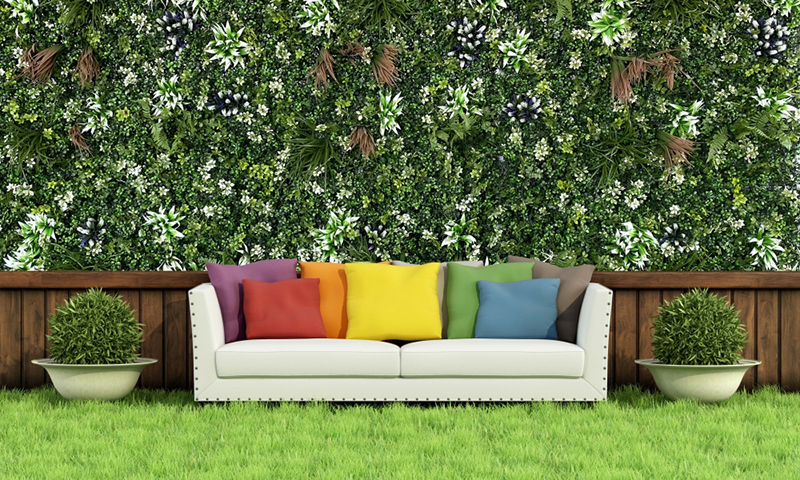Cold-Resistant Plant Selection for 3D Artificial Vertical Gardens: Designing Year-Round Green Walls in Challenging Climates
Artificial vertical gardens offer a practical solution for adding greenery to spaces exposed to harsh weather, but selecting cold-resistant plant designs enhances their realism and durability. Even in artificial setups, mimicking the hardiness of real cold-climate plants creates a more authentic aesthetic. Below are strategies for choosing and arranging artificial plants that evoke the resilience of alpine, boreal, and temperate species.

While artificial plants don’t face frost damage, their design can replicate the textures and forms of species adapted to cold environments. This creates a cohesive, nature-inspired look even in artificial gardens.
Evergreen Conifers: Use artificial spruce, pine, or fir branches to mimic the dense, needle-like foliage of real conifers. These designs add structure and year-round color, resembling the forests of northern regions. Opt for shades of deep green or blue-green to enhance their natural appearance.
Frost-Tolerant Broadleaf Evergreens: Incorporate artificial holly, boxwood, or rhododendron leaves to replicate the glossy, leathery textures of plants that survive freezing temperatures. These varieties work well as fillers or border plants in vertical arrangements.
Grasses and Sedges with Winter Appeal: Select artificial versions of cold-hardy grasses like blue fescue, feather reed grass, or sedges. Their fine blades and clumping habits mimic the way real grasses persist through snow and frost, adding movement and texture.
Cold-resistant plants often feature muted tones or seasonal highlights. Artificial designs can draw from these natural hues to create a harmonious, weather-appropriate aesthetic.
Subdued Greens and Gray-Greens: Stick to shades like olive, sage, or silvery-green to evoke the look of plants that thrive in overcast or snowy conditions. These colors blend seamlessly with stone, concrete, or metal surfaces common in modern outdoor spaces.
Accents of Red, Gold, or Bronze: Introduce artificial berries, twigs, or foliage in warm tones to mimic the seasonal color changes of real cold-climate plants. For example, artificial winterberry or dogwood stems add pops of red against green backgrounds.
White and Cream for a Frosty Effect: Use artificial plants with white-variegated leaves or delicate flowers to simulate the appearance of frost or snow. These details work well in transitional spaces like entryways or covered patios.
Even artificial plants benefit from arrangements that replicate how cold-resistant species grow in the wild. This authenticity makes the garden feel intentional and well-suited to its environment.
Clustering for Protection: Group artificial plants in tight clusters, as real cold-climate species often do to conserve heat and resist wind. For example, arrange artificial conifer branches or grasses in dense, overlapping layers to create a sheltered look.
Asymmetrical, Wind-Swept Forms: Position some artificial plants at slight angles or with irregular spacing to mimic the effect of strong winds or heavy snowfall. This adds a dynamic, natural feel to the garden.
Layering for Microclimates: Combine taller, more robust artificial plants like conifers with lower-growing varieties like sedges or heathers. This replicates the way real plants create microclimates, with taller species shielding shorter ones from harsh conditions.
Cold-climate gardens often feature a mix of rough and smooth textures. Artificial designs can use this principle to add visual complexity without the need for seasonal changes.
Rough, Bark-Like Stems: Use artificial branches with textured surfaces to mimic the look of real tree trunks or shrubs. These elements add depth and contrast when paired with softer foliage.
Fine, Needle-Like Foliage: Combine artificial conifer needles with broader leaves to create a tactile mix of textures. This approach works well in vertical gardens where depth is limited but visual interest is key.
Spiky or Prickly Accents: Introduce artificial plants with spiny leaves or stems, such as those inspired by barberry or hawthorn, to add a rugged, alpine feel. These details break up smoother textures and evoke the harsh beauty of cold landscapes.
By focusing on cold-climate-inspired designs, natural color palettes, authentic growth patterns, and textural contrast, artificial plants can transform 3D vertical gardens into resilient, visually striking installations. Their low-maintenance nature makes them ideal for regions with extreme weather, ensuring year-round beauty without the challenges of real frost-tolerant species.
Contact: Amy
Phone: 86-15311787313
E-mail: info@foszmac.com
Whatsapp:86-15311787313
Add: Fengtai District, Dacheng Road, No.24 Building, Room 203, Beijing, China